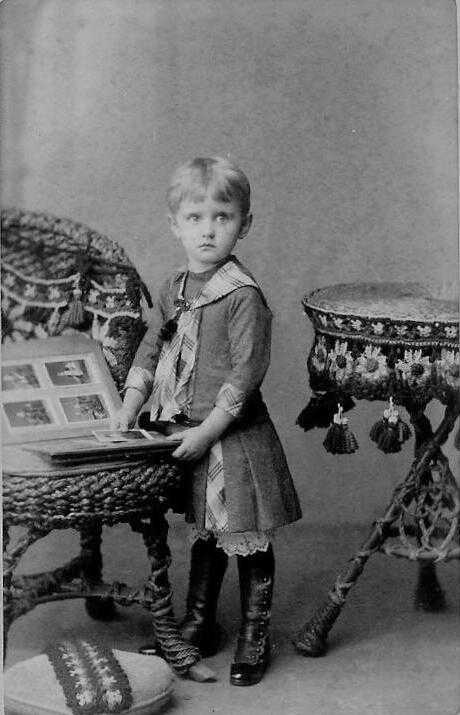
Photographic Album Types (19th Century)

Figure 1.--This CDV portrait shows a German child looking at the family CDV portrait album. We think the child is a boy, but we are not positive. Difficult to tell really. Center parts often indicate a girl. The child could be a girl. Short hair for girls was fashionable at the time, but this plain dress could be for a boy as well. The photographer was D. Wettern in Hamburg-Altona. The portrait is undated, but was probably taken about 1890. The child looks to be about 4 years old. I'm not sure, nbitthe child sems to be wearing leggings.
|
|
Albums appeared almost as soon as CDV portraits became popular. We see them in America by the very early 1860s, but they may hae appeared even erarlier in Europe. Daguerreotypes and ambrotyoes were not appropiate for albums. Portraits printed on paper-mounted cards were, however, just right. Affluent families might have albums with beaitifully tooled leather covers. Some might even have artistic script inside. Often there were metal claps to keep the allbum closed. Some even locked with a key. I'm not sure why that was seen as necessary. Less afflurnt families of course would have much more modest albums. The albums in the 19th century were made to hold specific types of portraits, including CDVs and cabinent cards. Tintypes were also kept in the albums, but this was a little more complicated as they were no standard size like CDVs and cabinent cards. The albums had slots into which the portraits were easily inserted. European albums were often for CDVs as that format was so popular there. Some albums had one image pages while others had slots for two or four images per page. After the turn of the 20th century with thee expansion of amateur photography and the snapshot, families began keeping photograph in what were foremly called scrapbooks. They were pasted into scrapbooks rather than being held in sloted pages.
Chronology
Albums appeared almost as soon as CDV portraits became popular. We see them in America by the very early 1860s, but they may hae appeared even erarlier in Europe.
Portrait Types
Daguerreotypes and ambrotyoes were not appropiate for albums. Portraits printed on paper-mounted cards were, however, just right. The albums in the 19th century were made to hold specific types of portraits, including CDVs and cabinent cards. Tintypes were also kept in the albums, but this was a little more complicated as they were no standard size like CDVs and cabinent cards. European albums were often for CDVs as that format was so popular there. The cabinent card albums were of course much larger than the CDV albums.
Covers
Affluent families might have albums with beaitifully tooled leather covers. Some might even have artistic in script inside. A good example of a finely toolded leather cover was a Civil War era album of the Schlesenger family. Less affluent families of course would have much more modest albums.
Clasps
Often there were metal claps to keep the allbum closed. Some even locked with a key. I'm not sure just why that was seen as necessary. It was, however, a very common conventin.
The CDV and cabinent card albums werecdone with stiff heavy card pages. The thivkness of the pages limited the number of pages in each album. Many had some decoration or highlighting around each image slot. The portraits were inserted into these slots. It was a way olf securing the portraits without danaging them. The were thus held securely. The albums varied in size. They could also be easily taken out and replaced if so desired. Some albums had small one image pages while others had slots for two or four images per page. A good example of ta two-image page is the Schlesinger album from the 1860s. The boy here has a four image page book (figure 1).
Scrapbooks
After the turn of the 20th century with the expansion of amateur photography and the snapshot, families began keeping photograph in what were foremly called scrapbooks. They were pasted into scrapbooks rather than being held in sloted pages. Some used pre-pacaged adhesive corners to better preserve the photographs.
HBC

Navigate the Boys' Historical Clothing Web Site:
[Return to:Main photographic album page]
[Return to:Main American 20th century family page]
[Introduction]
[Activities]
[Biographies]
[Chronology]
[Clothing styles]
[Countries]
[Topics]
[Bibliographies]
[Contributions]
[FAQs]
[Glossaries]
[Images]
[Links]
[Registration]
[Tools]
[Boys' Clothing Home]
Created: 6:27 AM 4/6/2008
Last updated: 3:39 PM 5/24/2008



